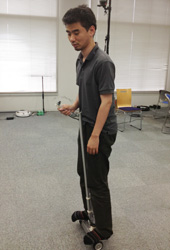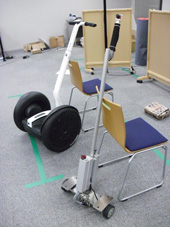 Index
Index

Hideki Hashimoto [profile]
Education Course
Is it Segway?
Hideki Hashimoto
Professor of Intelligent Space (Control Engineering, Robotics, Electric Power), Faculty of Science and Engineering, Chuo University

Photograph 1
We are currently researching and developing an upright two-wheeled vehicle as shown in photograph 1. You may be familiar with Segway, which is a vehicle invented a while ago that was said to change our transportation methods drastically. Many people may also remember the scene in which the then American President Bush was riding it around briskly. Prime Minister Koizumi also rode it.
You may be led to think that we are making Segway, but our product is not Segway. We are researching and developing a new type of electric stand-up two-wheeled vehicle, which can be put into the same category as Segway.
To make a long story short, we are producing an ultra-compact Segway-like vehicle.

Photograph 2
What is the difference with Segway? Please see photograph 2, which shows our product placed beside Segway. In comparison, their sizes are completely different. Although its height is 120 cm and nearly equal to that of Segway, its width and depth are about half of Segway. Its weight is about 7 kg, which is one fifth of Segway that weighs approximately 40 kg. They are both electric stand-up two-wheeled vehicles, but their difference is like that between a middle-aged man and an elementary student. You should not compare them. They are very different vehicles.
Children will grow and will still be able to ride the vehicle. Its size does not change, and this makes a meaningful difference.
The impact on the market
Two-wheeled objects are basically unstable. Bicycles cannot stay still unless you keep pedaling. Even skilled cyclists can only stay upright and keep that position for a couple of minutes by moving the handlebar vigorously. Naturally, the lying position is more stable, although humans chose to stand upright.
When seeing an electric stand-up two-wheeled vehicle for the first time, most people are astonished, seeing it standing against the law of nature. Furthermore, this vehicle moves freely while carrying a person. Nowadays, even one-wheeled vehicles can move in a surprisingly stable fashion. At the Tokyo Motor Show 2013, one-wheeled and two-wheeled vehicles, which are unstable in nature, moved around carrying passengers. These machines attracted attention especially from children, probably because they were futuristic.
The impact of electric stand-up two-wheeled vehicles is significant. Of course, once you see or ride it, the degree of surprise will diminish soon, but you will be left with an impression of a new vehicle. Automobile makers have started to proactively provide us with the information on one-wheeled and two-wheeled vehicles, which are still to be released, in order to secure future customers.
The impact on me
There is little impact of electric stand-up two-wheeled vehicles on those who have learned control engineering like me. I studied why these vehicles could stand stably from a textbook published 30 years ago, and so I was not impressed when I saw Segway for the first time. I insisted, “It is a mere application of control theory. Anyone can build it.” Researchers in the same academic field also mentioned, “This is easy to make. Where is the novelty and originality?” They added, “It is not worth writing a research paper,” to belittle the impact intentionally. As you can guess, they actually knew that the impact is quite large and were chagrined at being behind in producing such vehicles.
Even when the electric stand-up two-wheeled vehicle Segway debuted, I did not consider it as my research theme. I thought that there would not be much benefit by entering this field at the wrong timing.
Timing of R&D
Why are we producing an ultra-compact vehicle like Segway, over 10 years after Segway was released?
To put it simply, it would be fate. The advent of Segway produced a considerable impact on many researchers and engineers, including Company S, which is a globally renowned electronics firm. They launched a project for producing a compact electric stand-up two-wheeled vehicle inside the company, and prioritized production over writing papers. By 2006, a good machine had been produced, but Company S aborted the project, putting off its commercialization. As a result, several project members transferred to Company T, which is a globally prestigious automobile manufacturer, taking with them the outcome of the project, and others found jobs in other fields.
Some of my friends were project members, and left Company S several years ago. When discussing with them, who still kept pursuing two-wheeled vehicles, I came up with the idea of researching and developing an ultra-compact electric stand-up two-wheeled vehicle.
The world has continued to progress. Technologies have advanced somewhat over the past decade. New developments are now possible.
The idea
Our vehicle needs to be differentiated from single-passenger personal vehicles, such as Segway, and the electric stand-up two-wheeled vehicle of Company S. We thought that differentiation could be achieved by downsizing. A compact vehicle does not require space, and can run through any places where people can walk, and can be stored anywhere. In addition, lightweight vehicles would reduce the damage due to collision, and improve safety measures. More lightweight vehicles could be carried with one hand. Such a vehicle would be called a genuine mobile personal vehicle. This would be a different vehicle from Segway.
For a compact and lightweight vehicle, our goals were to:
(1) achieve smaller size than shoulder width, and
(2) target a weight of 5 kg or lighter so that a user can carry it with one hand.
We decided to attain the goal (1) by placing the motor and the wheels underneath the board for standing, and the goal (2) by reducing the weights of the motor and the battery as much as possible. It is still 2 kg overweight, but we can see the light at the end of the tunnel.
As a result, the wheels became too small to run over bumps and the battery became so small that it limited operating time. We worried that its performance would become poor and the vehicle would be useless.
Although there remain more items to be discussed, we thought of adding special values to our vehicle by giving the following three conditions:
(1) The vehicle can be used only inside large buildings, such as colleges, hospitals, and shopping malls. The vehicle cannot be used outdoors.
(2) The vehicle runs mainly on flat roads, floors, or the like. This vehicle can run over small obstacles, such as wires. However, users need to carry it for crossing a large obstacle and going up or down a stairway.
(3) After fully recharged, the vehicle can run for up to 30 minutes. Non-contact power feeding equipment is installed at many points. It is assumed that the vehicle will not run for over 30 minutes at once. If a user needs to drive it continuously, the user will be instructed to change vehicles.
Most of previous researches were aimed at running over a bump, going up and down a stairway, and enabling a vehicle to reach farther after recharge. By sacrificing these features, we chose to pursue an ultra-compact vehicle. Some may criticize that we have set a lower goal after being daunted, but actually we changed our concepts.
The magic broom
This vehicle cannot run outdoors, requires help for crossing a bump and going up or down a stairway, and takes a rest every 30 minutes. You may think that such a feeble vehicle is unreliable. However, we think that it is sufficient. We consider it as a useful transportation tool, and that what is moving is a human and the motions that humans are good at, such as crossing bumps and going up or down a stairway, should be done by themselves. Consequently, a compact and portable vehicle has been created.
On the other hand, in the field of automobiles for long-range transportation, researchers mainly focus on fully automatic driving. Passengers only have to ride them. If the automation of driving means the robotization of automobiles, the development of our vehicle means the transformation of a tool for supporting part of transportation. We assume that people voluntarily engage in transportation.
We will see whether this approach will be successful.
This feeble vehicle moves around in our laboratory in its delicate physique. It weighs only about 7 kg, but supports a person weighing 90 kg, and moves for as long as 30 minutes. When it runs by itself without carrying anyone, it looks like a domestic vacuum cleaner or a broom. We decided to call it a magic broom, likening it to the brooms in Fantasia of Disney, Kiki’s Delivery Service of Studio Ghibli, and Harry Potter. Our vehicle is definitely similar to a broom.
However, the machine is still to be released in the real society, sheltered in our laboratory. We plan to educate and bring her up a little further, before seeing her off. When she debuts, please welcome her warmly.
For details, please refer to http://www.elect.chuo-u.ac.jp/hlab.![]()
- Hideki Hashimoto
Professor of Intelligent Space (Control Engineering, Robotics, Electric Power), Faculty of Science and Engineering, Chuo University - Born in 1957 in Saga Prefecture, grew up in Tama (including three years in Shimonoseki), lives in Minato Ward, Tokyo. He entered Shimonoseki-nishi High School and graduated Toho High School.
In 1981 he graduated with a major in Electrical Engineering from the Faculty of Engineering, the University of Tokyo.
After working briefly in the electric power industry, he became a doctor of engineering with a PhD in Electrical Engineering from the University of Tokyo in 1987. He held positions at the same university as lecturer from 1987, associate professor from 1990, before becoming a professor of the Department of Electrical, Electronic, and Communication Engineering on the Faculty of Science and Engineering at Chuo University in 2011.
From 1989 to 1990 he was a visiting scientist at MIT. He was also a visiting professor at Nagoya University, Budapest University of Technology and Economics, and Seoul National University. He has been engaged in research on intelligent spaces that make use of control technology, robotics, and electric power, and is conducting research in areas including personal mobility, energy management combining wireless power transmission and ESD (Energy Storage Devices), and sleep-inducing robots.
http://www.elect.chuo-u.ac.jp/hlab
- Research Activities as a Member of Research Fellowship for Young Scientists (DC1), Japan Society for the Promotion of Science (JSPS) Shuma Tsurumi
- Important Factors for Innovation in Payment Services Nobuhiko Sugiura
- Beyond the Concepts of Fellow Citizens and Foreigners— To Achieve SDGs Goal 10 “Reduce Inequality Within and Among Countries” Rika Lee
- Diary of Struggles in Cambodia Fumie Fukuoka
- How Can We Measure Learning Ability?
—Analysis of a Competency Self-Assessment Questionnaire— Yu Saito / Yoko Neha - The Making of the Movie Kirakira Megane








